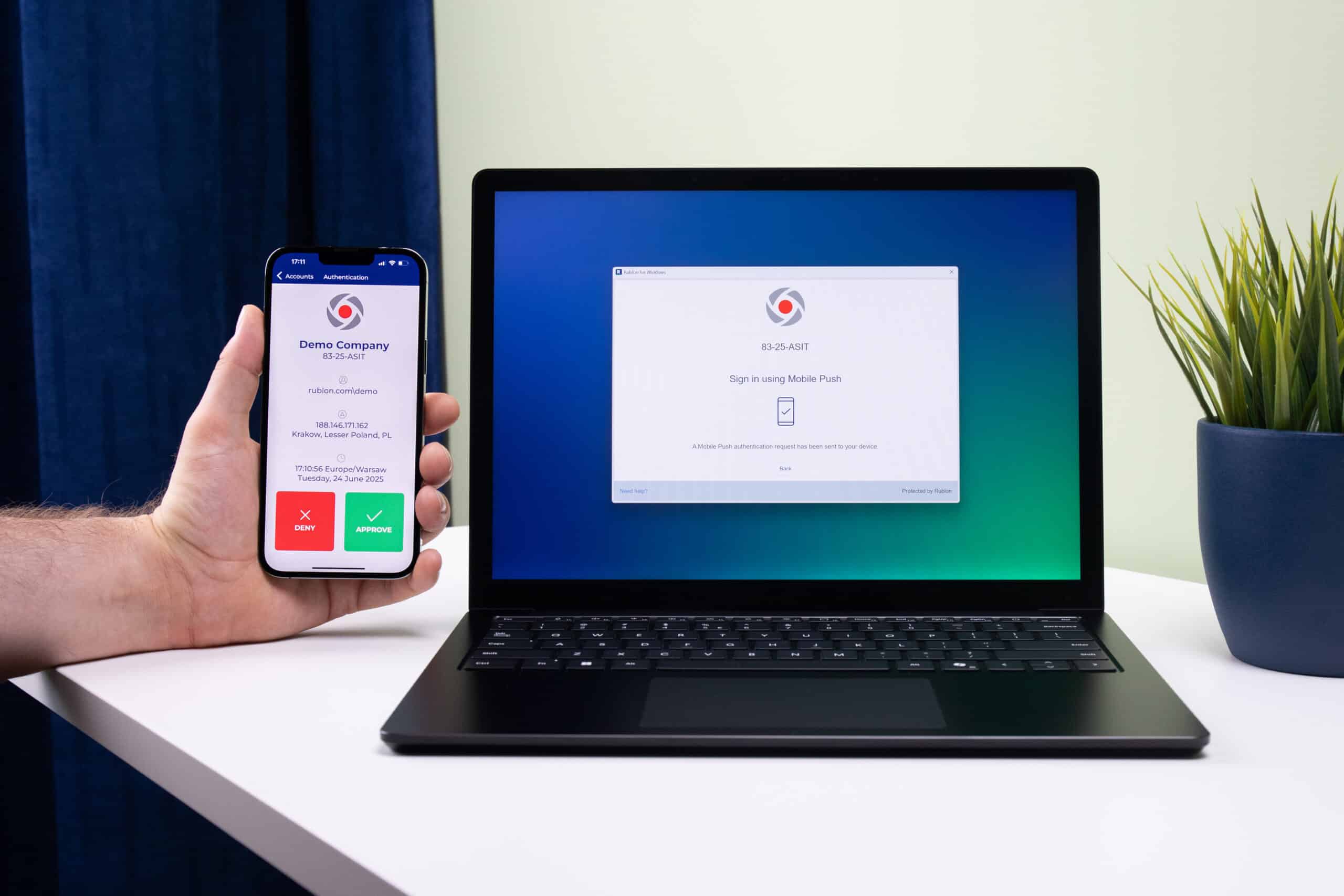Last updated on September 23, 2025
Mobile Push is the fastest and most comfortable method of authentication. Mobile Push combines high security with a one-tap, user-friendly approach. Install Rublon Authenticator on your phone. When you log in to an application integrated with Rublon, you have to provide your credentials, that is, your username and password. In the second step, you get a push notification on your phone. Tapping Approve logs you in to the integrated application. No hassle. No problems. No stress. Look:

Mobile Push protects you from fraudulent attempts to access your data. The push notification sent to your phone contains the following information about the login attempt:
- Username – the username of the user who wants to log in
- IP – the IP address of the device on which the login attempt is taking place
- Location – the geographical location of the device on which the authentication attempt is taking place
- Datetime – the time and date of the authentication

Analyzing the preceding information helps you decide whether the authentication request really comes from you and if all the information is correct. With Mobile Push, you will always be sure it is you who tries to log in. Rublon Mobile Push gives you the power to deny anybody else and protect your data.

Auto Push
Auto Push automatically selects Mobile Push as the second factor during Rublon Authentication.
When Auto Push is enabled, the user automatically receives a Mobile Push notification on their phone.
To enable Auto Push, go to the Rublon Admin Console and edit the Global Policy or create a new Custom Policy. Then, click Authentication Methods on the left and set the Default Authentication Method to Mobile Push. Note that you can also select any other method, e.g., select Mobile Passcode for Auto Passcode.
List Of Integrations That Support Mobile Push
- Active Directory Federation Services (AD FS)
- Aha!
- Amazon WorkSpaces
- Awingu
- AWS Client VPN
- Barracuda VPN
- BambooHR
- Bugsnag
- Bonusly
- Certify
- Check Point Mobile Access VPN
- Cisco AnyConnect VPN with ASA
- Cisco AnyConnect VPN with Cisco FTD Firepower Firewall – RADIUS
- Cisco AnyConnect VPN with Cisco FTD Firepower Firewall – LDAP(S)
- Cisco FirePower Management – RADIUS
- Cisco FirePower Management – LDAP(S)
- Cisco Meraki Client VPN
- Cisco RV Series VPN
- Citrix Gateway
- Confluence Server and Data Center
- Confluent
- Dell iDRAC
- Dropbox
- EESM ForestSafe
- Envoy
- F5 BIG-IP APM
- Fastly
- FogBugz
- Fortinet FortiGate SSL VPN
- Fortinet FortiMail
- Freshdesk
- GitHub
- G Suite
- HackerRank for Work
- HP Anyware
- Jamf Pro
- Jira Server and Data Center
- Jitbit
- Kemp
- Microsoft RRAS
- MikroTik VPN
- MikroTik Router Management Tools
- Moodle
- Nextcloud
- Office 365
- OpenCart
- Open edX
- OpenVPN
- OpenVPN Cloud
- Outlook Web App (OWA)
- ownCloud
- PagerDuty
- Palo Alto GlobalProtect VPN
- Parallels RAS
- ParkMyCloud
- Pingdom
- Pulse Connect Secure SSL VPN
- Remote Desktop Gateway (RD Gateway)
- Remote Desktop Protocol (RDP)
- Remote Web Access (RD Web)
- Remote Desktop Web Client (RD Web Client)
- Roundcube
- Salesforce
- Snipe-IT
- SOGo
- SonicWall SSL VPN
- SonicWall WAN GroupVPN
- SonicWall SMA
- Sophos Firewall
- Sophos UTM
- Splunk
- SSH on Linux
- Sumo Logic
- Stormshield SSL VPN
- Veritas NetBackup
- VMware Horizon View (VDI)
- WatchGuard Firebox
- Weekdone
- Windows Logon
- WordPress
- Zabbix
- Zendesk
- Zimbra Collaboration
- Generic SAML Service Providers